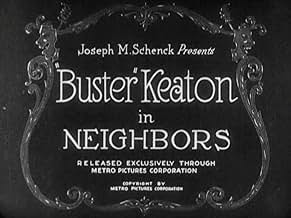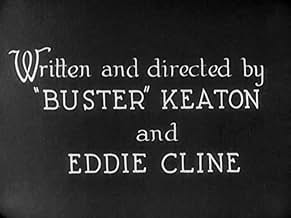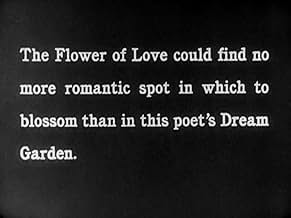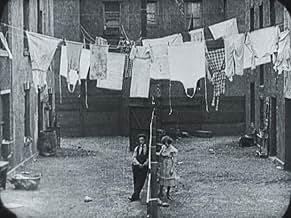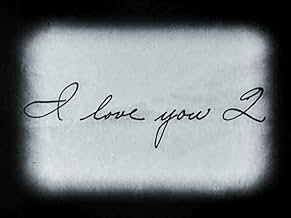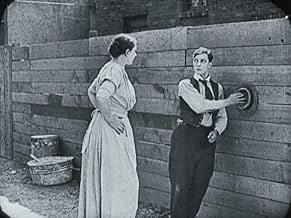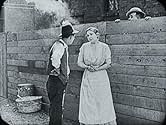IMDb-BEWERTUNG
7,5/10
4933
IHRE BEWERTUNG
Füge eine Handlung in deiner Sprache hinzuA young couple who live next to each other in tenement apartments do everything they can to be together despite of their feuding families.A young couple who live next to each other in tenement apartments do everything they can to be together despite of their feuding families.A young couple who live next to each other in tenement apartments do everything they can to be together despite of their feuding families.
- Regie
- Drehbuch
- Hauptbesetzung
Edward F. Cline
- The Cop
- (Nicht genannt)
Jack Duffy
- The Judge
- (Nicht genannt)
The Flying Escalantes
- Themselves
- (Nicht genannt)
Virginia Fox
- The Girl
- (Nicht genannt)
Joe Keaton
- His Father
- (Nicht genannt)
Joe Roberts
- Her Father
- (Nicht genannt)
Empfohlene Bewertungen
A BUSTER KEATON Silent Short.
Buster's romance with the pretty girl across the back fence leads to great trouble with the NEIGHBORS.
Keaton's superb athletic abilities are highlighted in this very funny little film. The backs of the tenement houses were constructed to Buster's exact physical specifications, giving him hand & foot holds precisely where he would need them, allowing him to climb, slide, cling, tumble, etc., culminating in the hilarious three-man high stunts that climax the film. Big Joe Roberts plays the beefy papa of Buster's beloved.
Born into a family of Vaudevillian acrobats, Buster Keaton (1895-1966) mastered physical comedy at a very early age. An association with Fatty Arbuckle led to a series of highly imaginative short subjects and classic, silent feature-length films - all from 1920 to 1928. Writer, director, star & stuntman - Buster could do it all and his intuitive genius gave him almost miraculous knowledge as to the intricacies of film making and of what it took to please an audience. More akin to Fairbanks than Chaplin, Buster's films were full of splendid adventure, exciting derring-do and the most dangerous physical stunts imaginable. His theme of a little man against the world, who triumphs through bravery & ingenuity, dominates his films. Through every calamity & disaster, Buster remained the Great Stone Face, a stoic survivor in a universe gone mad.
In the late 1920's Buster was betrayed by his manager/brother-in-law and his contract was sold to MGM, which proceeded to nearly destroy his career. Teamed initially with Jimmy Durante and eventually allowed small roles in mediocre comedies, Buster was for 35 years consistently given work far beneath his talent. Finally, before lung cancer took him at age 70, he had the satisfaction of knowing that his classic films were being rediscovered. Now, well past his centenary, Buster Keaton is routinely recognized & appreciated as one of cinema's true authentic geniuses. And he knew how to make people laugh...
Buster's romance with the pretty girl across the back fence leads to great trouble with the NEIGHBORS.
Keaton's superb athletic abilities are highlighted in this very funny little film. The backs of the tenement houses were constructed to Buster's exact physical specifications, giving him hand & foot holds precisely where he would need them, allowing him to climb, slide, cling, tumble, etc., culminating in the hilarious three-man high stunts that climax the film. Big Joe Roberts plays the beefy papa of Buster's beloved.
Born into a family of Vaudevillian acrobats, Buster Keaton (1895-1966) mastered physical comedy at a very early age. An association with Fatty Arbuckle led to a series of highly imaginative short subjects and classic, silent feature-length films - all from 1920 to 1928. Writer, director, star & stuntman - Buster could do it all and his intuitive genius gave him almost miraculous knowledge as to the intricacies of film making and of what it took to please an audience. More akin to Fairbanks than Chaplin, Buster's films were full of splendid adventure, exciting derring-do and the most dangerous physical stunts imaginable. His theme of a little man against the world, who triumphs through bravery & ingenuity, dominates his films. Through every calamity & disaster, Buster remained the Great Stone Face, a stoic survivor in a universe gone mad.
In the late 1920's Buster was betrayed by his manager/brother-in-law and his contract was sold to MGM, which proceeded to nearly destroy his career. Teamed initially with Jimmy Durante and eventually allowed small roles in mediocre comedies, Buster was for 35 years consistently given work far beneath his talent. Finally, before lung cancer took him at age 70, he had the satisfaction of knowing that his classic films were being rediscovered. Now, well past his centenary, Buster Keaton is routinely recognized & appreciated as one of cinema's true authentic geniuses. And he knew how to make people laugh...
An imposible love story becomes pretext for gags and fascinating adventures. And start point for a great reflection of the genius of one of magnificent actors. A film who could be a Chaplin one. But the difference consists, first, in the force of nuances. And in the impecable art of Buster Keaton to transform ordinary situations in roots of impressive gems.
No, nothing to do with the Aussie soap opera. This "Neighbors"- I keep the original American spelling- is a silent comedy short from 1920. The plot is a comic take on the "Romeo and Juliet" story. Buster Keaton and Virginia Fox play young lovers who live in flats in adjoining buildings but whose families are constantly quarrelling with one another. Both families are, of course, hostile to the young people's relationship, and the film is the story of how Buster and Virginia overcome the obstacles to their love. (I use the names of the actors because we never find out the names of their characters. The cast-list simply refers to "The Boy" and "The Girl").
Modern rom-coms also often deal with how young couples deal with the obstacles to their love, but today such "obstacles" are generally metaphorical- not only parental disapproval but also things like differences in social class or a fear of commitment. This being a silent comedy, however, the obstacles in "Neighbors" can be literal, physical barriers such as a wooden fence separating the two properties and the fact that Virginia's bedroom is on the third floor. Buster has to use his acrobatic skills to overcome these barriers with circus-style stunts involving a trapeze and much balancing on top of ladders.
Films like this were a part of my childhood in the sixties and seventies because they were often shown on British television. I suspect that this was done to provide a nostalgic treat for my grandparents' generation, who would have remembered them from their youth, but they also proved popular with my own generation. My parents were both born in the thirties and, having grown up after the sound revolution, regarded silents as very old-fashioned, so I often ended up watching them with Grandma and Grandpa. I was certainly not alone among my schoolfriends in my enthusiasm for these old films; they were not expressly made as children's films, but there was obviously something about their physical style of humour which appealed to the young.
To the modern adult, this style of humour can seem as unsophisticated as it did to my parents; one of the gags, for example, involves Buster's trousers falling down during the wedding ceremony after his belt breaks. We have to remember, however, that the cinema of the 1910s and early 1920s was, of necessity, experimental. Silent acting, whether in comedy or serious drama, was something new, and film-makers could not rely upon the traditional skills of the theatre, where actors could speak. Pioneers like Keaton, who acted as co-writer and co-director of this film, had to be continually experimenting to find out what worked and what didn't. And in "Neighbors" he does sometimes succeed in making us laugh.
Modern rom-coms also often deal with how young couples deal with the obstacles to their love, but today such "obstacles" are generally metaphorical- not only parental disapproval but also things like differences in social class or a fear of commitment. This being a silent comedy, however, the obstacles in "Neighbors" can be literal, physical barriers such as a wooden fence separating the two properties and the fact that Virginia's bedroom is on the third floor. Buster has to use his acrobatic skills to overcome these barriers with circus-style stunts involving a trapeze and much balancing on top of ladders.
Films like this were a part of my childhood in the sixties and seventies because they were often shown on British television. I suspect that this was done to provide a nostalgic treat for my grandparents' generation, who would have remembered them from their youth, but they also proved popular with my own generation. My parents were both born in the thirties and, having grown up after the sound revolution, regarded silents as very old-fashioned, so I often ended up watching them with Grandma and Grandpa. I was certainly not alone among my schoolfriends in my enthusiasm for these old films; they were not expressly made as children's films, but there was obviously something about their physical style of humour which appealed to the young.
To the modern adult, this style of humour can seem as unsophisticated as it did to my parents; one of the gags, for example, involves Buster's trousers falling down during the wedding ceremony after his belt breaks. We have to remember, however, that the cinema of the 1910s and early 1920s was, of necessity, experimental. Silent acting, whether in comedy or serious drama, was something new, and film-makers could not rely upon the traditional skills of the theatre, where actors could speak. Pioneers like Keaton, who acted as co-writer and co-director of this film, had to be continually experimenting to find out what worked and what didn't. And in "Neighbors" he does sometimes succeed in making us laugh.
This is one of the few short films that was understated on the back on the DVD. Usually they make it sound better than it often winds up. Despite little buildup, this was tremendous fun for 18 minutes.
The very beginning is very innocent as Harold and Virginia Fox exchange love notes through a peephole in a fence that divides their family's tenement properties. Quickly, the parents of each come out, intercept the messages, disapprove, meddle further and then get involved in one wild and crazy scene after another. Featured are some terrific stunts and just general madness and mayhem with one funny sight gag after another. This is so frenetic that it has to be seen, not read about. Just be ready for a wild ride of feuding neighbors and cops.
It does calm down for a minute or two when a judge makes the parents sign a "peace treaty." Harold then announces he and Virginia are going to get married.....and they try to do that but, a combination of pants that won't stay up (don't ask) and Virginia's father, Big Joe Roberts, break that up. Now we go back to slapstick and clever scenes as Buster's friends help get his girl back. It's another crazy finish, albeit a short one.
It's very inventive stuff and one of Harold's best. It is an extra on the "Seven Chances" DVD. Note: Playing Buster's dad in here was his real-life father, Joe Keaton.
The very beginning is very innocent as Harold and Virginia Fox exchange love notes through a peephole in a fence that divides their family's tenement properties. Quickly, the parents of each come out, intercept the messages, disapprove, meddle further and then get involved in one wild and crazy scene after another. Featured are some terrific stunts and just general madness and mayhem with one funny sight gag after another. This is so frenetic that it has to be seen, not read about. Just be ready for a wild ride of feuding neighbors and cops.
It does calm down for a minute or two when a judge makes the parents sign a "peace treaty." Harold then announces he and Virginia are going to get married.....and they try to do that but, a combination of pants that won't stay up (don't ask) and Virginia's father, Big Joe Roberts, break that up. Now we go back to slapstick and clever scenes as Buster's friends help get his girl back. It's another crazy finish, albeit a short one.
It's very inventive stuff and one of Harold's best. It is an extra on the "Seven Chances" DVD. Note: Playing Buster's dad in here was his real-life father, Joe Keaton.
Neighbors (1920)
*** (out of 4)
Buster Keaton does the Romeo and Juliet storyline as he falls in love with his neighbor but it'll be hard to get married since the families hate one another. There are plenty of good gags here including the human fly swatter gag and the stuff dealing with Keaton trying to avoid the police. Keaton also delivers one of his best stunts and three people on one another's shoulders try and walk from house to house with Keaton being three stories up.
Available on Kino's The Art of Buster Keaton Collection, which is one of the greatest box sets out there.
*** (out of 4)
Buster Keaton does the Romeo and Juliet storyline as he falls in love with his neighbor but it'll be hard to get married since the families hate one another. There are plenty of good gags here including the human fly swatter gag and the stuff dealing with Keaton trying to avoid the police. Keaton also delivers one of his best stunts and three people on one another's shoulders try and walk from house to house with Keaton being three stories up.
Available on Kino's The Art of Buster Keaton Collection, which is one of the greatest box sets out there.
Wusstest du schon
- WissenswertesIncluded in "Buster Keaton: The Shorts Collection" blu-ray set, released by Kino.
- Zitate
His Father: He's my son and I'll break his neck any way I please!
- VerbindungenEdited into The Golden Age of Buster Keaton (1979)
Top-Auswahl
Melde dich zum Bewerten an und greife auf die Watchlist für personalisierte Empfehlungen zu.
Details
- Laufzeit18 Minuten
- Sound-Mix
- Seitenverhältnis
- 1.33 : 1
Zu dieser Seite beitragen
Bearbeitung vorschlagen oder fehlenden Inhalt hinzufügen

